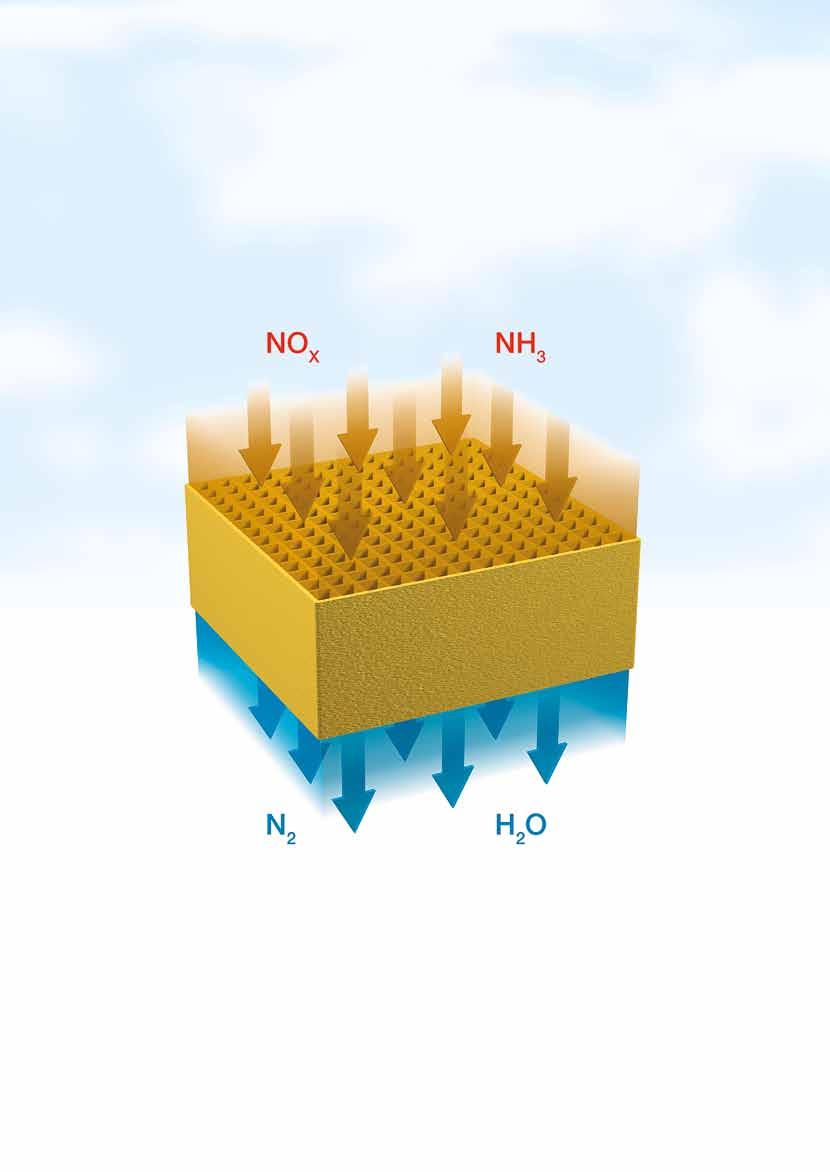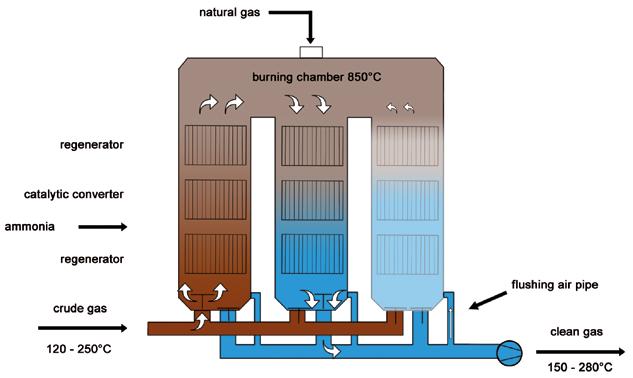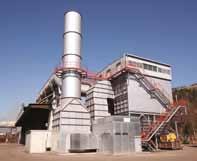Selective Catalytic Reduction (SCR)





Exhaust gases from the cement kiln leave the preheater at a temperature of 300 – 380°C, which is the ideal temperature range for catalytic denitrification. Depending on the specific requirements, up to 5 catalytic layers can be integrated into a single reactor to allow the required emissions level to be maintained. The dust-laden exhaust gas (dust
content up to 200 g/Nm³) is conveyed vertically downwards. To prevent the channels from becoming clogged, each catalytic layer is cleaned by means of a highly-efficient cleaning concept. By taking advantage of the temperature level, heating of the exhaust gas is unnecessary, which has a positive effect on operating costs.

 Crude gas
Ammonia injection
3 – 4 Catalytic layers
Crude gas
Ammonia injection
3 – 4 Catalytic layers
A significant proportion of the exhaust gas heat from a cement plant is used for drying raw materials and fuels, and leaves the kiln filter at a temperature of 100 – 250°C. The temperature of the dedusted exhaust gas is too low for breakdown to take place in the catalytic converter. For breakdown to occur, temperatures of 220 – 300°C are required. With heat exchangers some of the energy used for heating can be recovered. In

normal operation, only the temperature loss of the heat exchanger needs to be compensated using an external energy source (heat displacement from other exhaust gas flows, natural gas burners). This circuit version has the advantage of requiring relatively small catalytic volumes, owing to the fact that the exhaust gas has already been dedusted. This also helps to ensure the longer service life of the catalytic converters.


The DeCONOx process is the combination of a regenerative thermal oxidation (RTO) with a low-dust SCR (selective catalytic reduction). It combines these two tested technologies in one system. Nitrogen oxides and carbon compounds can be simultaneously reduced with the DeCONOx process. The breakdown of NO x takes place through catalytic reduction using ammonia and the breakdown of carbon compounds takes place through combustion
(thermal oxidation in the combustion chamber). At best, the heat arising in the afterburning process covers the entire thermal energy requirement (autothermal operation) for the denitrification, which is necessary for the reheating of the flue gas to the required operating temperature of the catalytic converter. As a result, the energy expenditure of the DeCONOx process is reduced considerably in comparison to a low-dust SCR.

The two-tower version is the simplest form of this system. The flue gas flows alternatingly in each of the towers. The switching takes place in one-minute cycles, whereby the gas absorbs the heat in the upward flow and releases the heat again in the downward flow. In order to guarantee a complete oxidation, the combustion chamber is regulated to
a temperature of 850°C. The catalytic converter is located in the optimum temperature range between the regenerators to allow a catalytic reaction to take place. For use in large industrial plants, DeCONOx versions with three, five or seven towers are provided, where one tower is flushed in order to eliminate peaks of harmful substances in the clean gas.
The new SCR process - „semi-dust crude gas circuit“ - for NO x separation was implemented for Lafarge Perlmooser GmbH in Mannersdorf, Austria. It is the world´s first industrial application of its type for the cement industry. This plant is designed for an NO x limit value of 200 mg/Nm³.
The kiln exhaust gas is first dedusted in a hightemperature dry electrostatic precipitator and then passes through the multi-layer catalytic converter. With the integration of a gas conditioning tower below the catalytic converter for exhaust gas cooling, the filter inlet temperature required in direct operation is assured. The dust separated in the dry electrostatic precipitator is conveyed back to the exhaust gas flow by means of a pneumatic dust conveyor pump.

The specified value of 200 mg/Nm³ for the NO x separation was permanently adhered to, and from an operational costs perspective, the values in respect to energy and harmful substance consumption were even undercut.
Due to the good degree of separation of the SCR plant - the requisite clean gas value is achieved with this plant alone - the existing SNCR plant for the preliminary denitrification is not necessary. The result is an additional, considerable savings in operational costs.
Initial catalytic converter analyses indicate a relatively low activity loss after one year of operation, however more specific statements can only be made after extended periods of operation. A positive side-effect of this semi-dust circuit: Any existing organic compounds are simultaneously broken down.
The application spectrum of the basic IMPULS filter product program with its efficient IMPULS cleaning system and many different variations ranges from classic dedusting to the filtration of process gases and hot gas. The IMPULS-COMPACT filter series for so-called “secondary dedusting“ applications is factory pre-assembled, equipped with hoses and delivered ready for connection, optionally supplemented with an integrated fan unit and sound suppressor.
In the last ten years, Scheuch’s EMC filter technology has revolutionized the dedusting process in the cement industry. The technology was able to set new standards with respect to bag length, pressure loss, cleaning pressure and the service life of filter bags. The result has manifested itself in a significant reduction of life cycle costs (LCC).





In order to be able to use economically available filter media for clinker cooler dedusting, an exhaust gas cooling system (air/air heat exchanger) is used to adjust the gas temperatures to the filter inlet temperature. The energy amounts released in this process are fed via heat extraction to a regenerative waste heat recovery system.
These are system-specific designs for achieving maximum efficiency. With our comprehensive know-how in plant engineering and manufacturing and the assured quality of our own in-house manufacturing program, Scheuch’s radial fan units guarantee high plant availability and long service lifetimes.
For high performance levels during the entire life cycle with the services plant analysis and consultation, measurements (dust, pollutants, noise), repairs, inspection and maintenance, factory overhauls of component groups/exchange program, original spare parts service, and modernization/updates to improve performance and/or save energy.